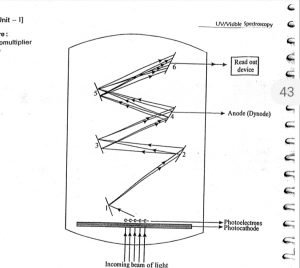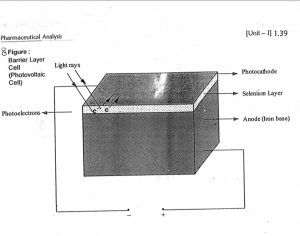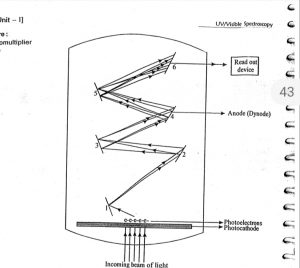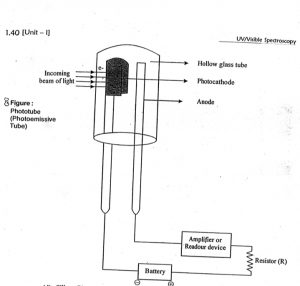Instrumentation of UV-Visible Spectroscopy Part-2 and Question Answer based on it
INSTRUMENTATION OF UV-VISIBLE SPECTROSCOPY :-
- Radiation source
- Monochromator
- COLLIMATING SYSTEM
- Filter
- Sample cell
- Detector
Sample cell :-
Sample cell are used to hold a sample solution. The material of sample cell should not absorb at the wavelength being observed. Sample cell are cylindrical or rectangular in shape.
The pathlength the cells are 10 mm or 1 cm.
Detectors :-
Detector are the device which convert light energy into electrical signal that are display on the read out device.
There are mainly three types of detector are used in UV-VISIBLE SPECTROSCOPY
1. Photo multiplier tube :- is quite sensitive cathode and about 10 anode which are maintained at a potential of 75- 100 volta.
Working :- It is work on principal of multiplication of the photo electrons by secondary emissions of electron.
When a beam of light fall on the photo cathode, photo electrons are generated which are accelerate towards the anode. At each stage of their accelerate from one anode to another anode the emissions of electron is increase by a factor 4 to 5 due to secondary emissions of electron.

2. Photo voltaic cell :-
It is consists of a photo cathode which is a thin metallic layer coated with gold or silver. It is also contain a metal base which act as anode. Between these two electrod is a semi conductor layer of selenium.
Working :- while light ray falls on the selenium layer electron are generated which are taken by the photo cathode.
Because of the poor electrical conductivity of the selenium the electron he accumulated on the cathode leading to the development of the potential difference across the two electrod which result to generate electric current.

3. Photo tube :-
It consists of a hollow glass tube with a photo cathode and a collector anode. The surface of the photo cathode is coated with a layer of element like cesium, potassium, silver oxide.
Working :-
When light fall on the photo cathode , electron are produced which flow towards the collect or anode and generate current. The amount of current generate is directly proportional to the intensity of the light radiation.


Their are mainly two types of UV-VISIBLE INSTRUMENTS
1. Single beam

2. Double beam

Single beam UV-VISIBLE :-
In a single beam UV-VISIBLE spectro-photometer light from the radiation source is passed through out the monochromator enters the sample cell containing the sample cell solution.
A part of the incident light is absorbed by the sample and remaining get transmitted .
The transmitted light strikes the detector and produced electrical signal.
The signal produced by the detector is directly proportional to the intensity of the light beam striking it surface.
The absorbance reading both the standard and unknown solution are recorded.
After adjust the instrument to 100% transmission with a blank solution each time when even the wavelength is charged.
MCQ
1. Which material are used to made sample cell ?
A. Silver
B. Silicon
C. Quartz
D. None of this
2. The pathlength of the sample cell is
A. 100cm
B. 1 cm
C. 1009 cm
D. 10 cm
3. Which device is used to convert light energy into electrical signal ?
A. Amplifier
B. Detector
C. Sample cell
D. Slit
4. How many potential difference between two electrode in PMT ?
A. 75 – 100 volt
B. 109 volt
C. 100-105 volt
D. 50- 75 volt
5. Which material are used to coated cathode ?
A. Gold
B. Silver
C. A and B
D. None of this
6. In photo voltaic cell which material is used as layer between cathode and anode ?
A. Selenium
B. Aluminum
C. Au
D. Ag
Answer key
1. C
2. D
3. B
4. A
5. C
6. A
Reference: book of analysis- third edition by ravi sankar.